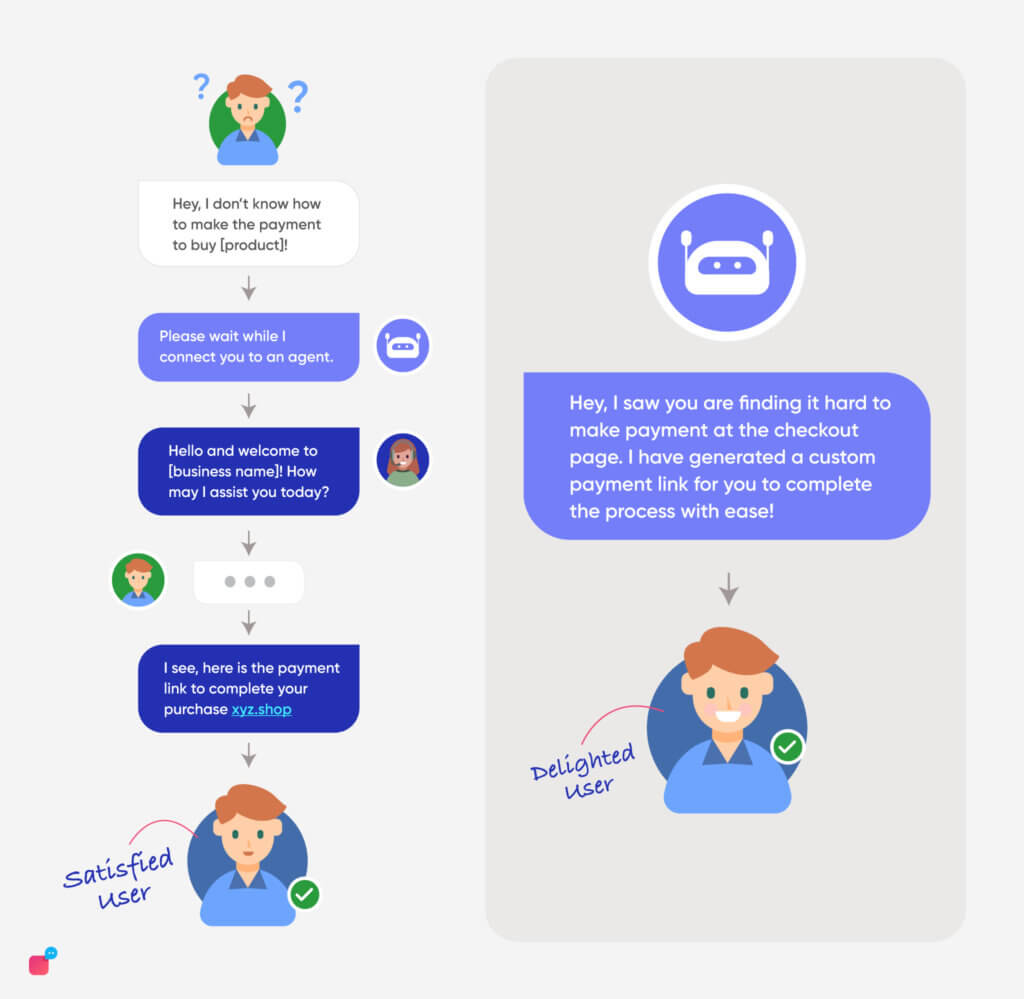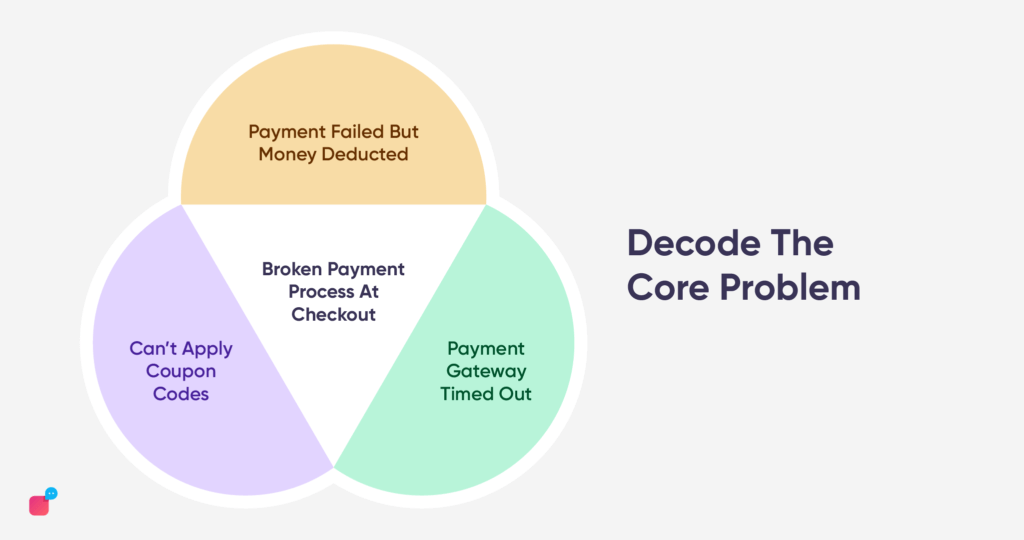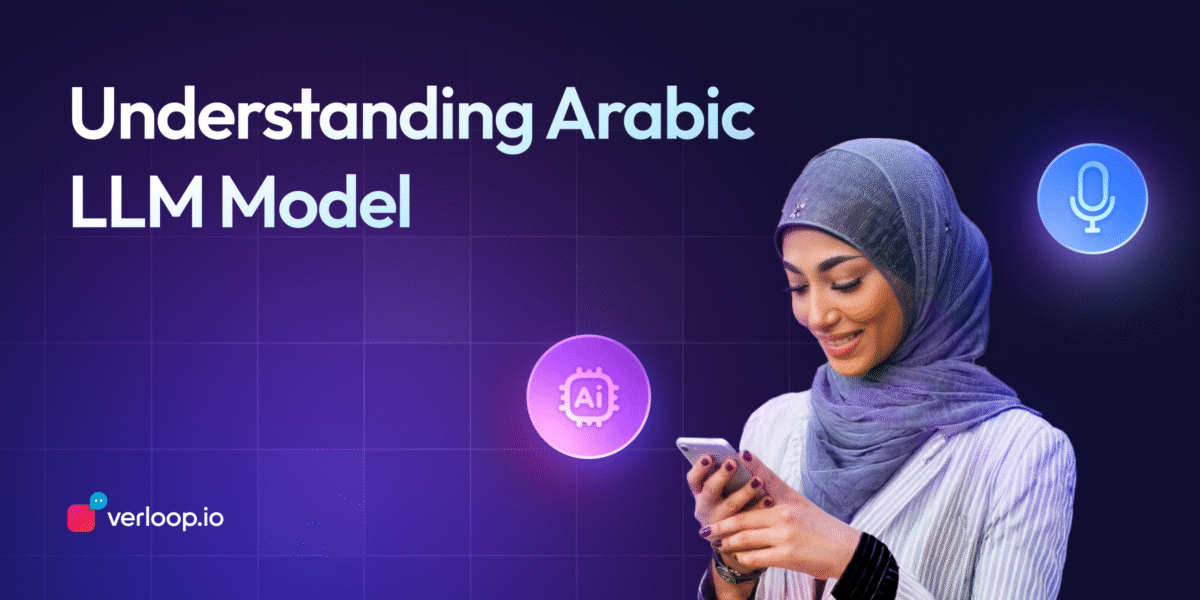The Future of Conversational AI
- August 6th, 2025 / 5 Mins read
-
Aarti Nair

The Future of Conversational AI
- August 6th, 2025 / 5 Mins read
-
Aarti Nair
Automation.
When you hear the word, what comes to mind?
A picture showing gears and levers flowing in unison to make something work? In the digital world, it’s no different either. Automation has helped companies fix process gaps to ensure watertight front-end functionality. And when we speak of frontline automation, conversational AI is a natural progressor of the discussion.
For one, conversational bots have made digital-first companies more resilient in today’s times. They have allowed them to connect and interact with their users better and deliver delightful customer support at every touchpoint.
But what does the future of conversational AI look like?
We sat down with some top industry experts, Nitin Somalraju from Tech Mahindra, Athira S M, previously from Milaap, and Danish Muti from Scaler Academy, to understand
- Where this industry seems to be heading?
- How can we expect automation and conversational AI to progress in the coming days?
- What impact will it have on the way we build customer relationships?
- How is AI redefining the customer support we render to our modern customers?
Least to say, our conversations have been nothing short of enlightening. Here are our best picks!
Suggested reading: 5 Leaders. 5 Tips. 1 Goal. Build Delightful Customer Support.

What is Conversational AI?
When was the last time you asked a chatbot about your order status or spoke to a virtual assistant to set a reminder? Chances are, it wasn’t too long ago. Whether we realise it or not, conversational AI is already woven into the fabric of our digital interactions.
But what exactly is it?
Conversational AI refers to the set of technologies that enable machines to understand, process, and respond to human language—whether written or spoken—naturally and intelligently. At its core, it combines natural language processing (NLP), machine learning (ML), and speech recognition to power virtual assistants, chatbots, and voicebots that can hold meaningful conversations with users.
And the world is taking notice.
According to a report by Grand View Research, the global conversational AI market is projected to reach USD 41.39 billion by 2030, growing at a compound annual growth rate (CAGR) of 23.6% from 2023. This isn’t just a sign of rapid adoption—it signals a profound shift in how businesses communicate with their customers, and how users expect to be engaged.
Why is this growth happening so fast? It’s simple: today’s users demand convenience, speed, and personalisation. And conversational AI delivers all three—at scale.
Still, some might wonder: Is it just about automating responses? Or is there more to the story?
Different Types of Conversational AI
Not all conversational AI is created equal.
While it’s easy to lump every chatbot or voice assistant under one umbrella, the truth is that conversational AI comes in various forms—each serving a unique purpose and offering different levels of complexity. So, how do you know which type is best suited for your business, or even your daily interactions?
Let’s break it down.
1. Rule-Based Chatbots
Think of these as digital decision trees. Rule-based chatbots follow predefined scripts and respond to specific keywords or phrases. They’re great for handling basic queries—like store hours or order status—but fall short when conversations go off-script. There’s no real understanding here, just if-then logic.
So why are they still used? Because they’re quick to deploy, cost-effective, and suitable for simple, repetitive tasks. But as customer expectations evolve, rule-based bots often fail to keep up.
2. AI-Powered Chatbots
Enter the next generation.
Unlike their rule-based counterparts, AI chatbots use natural language processing (NLP) and machine learning (ML) to understand user intent and context. They can hold more fluid conversations, learn from interactions, and improve over time. You’ve likely interacted with one when chatting with an e-commerce support bot that understood your query even when you didn’t phrase it perfectly.
These bots mark the shift from scripted responses to real-time understanding—but they’re still limited in how much they can actually do.
3. Voice Assistants
We’re all familiar with the likes of Siri, Alexa, or Google Assistant. These are voice-driven conversational AI tools that use automatic speech recognition (ASR) to interpret spoken language and generate responses using text-to-speech (TTS) technology.
Voice assistants are especially useful in hands-free environments—driving, cooking, or multitasking—but their value in business contexts is growing too. From booking appointments to processing payments, voice-first interactions are becoming more common, especially in industries like healthcare, banking, and travel.
4. AI Agents (Chat and Voice)
And then we have AI agents—the most advanced form of conversational AI.
Unlike traditional bots, AI agents go beyond answering questions. They can perform tasks, make decisions, and even take proactive actions based on real-time data. Think of them as digital employees—trained not only to understand customers but to act on their behalf.
For instance, an AI voice agent in a contact centre might not just tell a customer their account balance—it can detect intent, authenticate the user, and process a refund, all within the same interaction. In a chat interface, AI agents can handle everything from lead qualification to post-sale support, without needing to escalate to a human unless necessary.
What sets AI agents apart is their ability to integrate with internal systems (like CRMs or ERPs), allowing them to personalise conversations and automate workflows end-to-end.
So, as we look at the future of customer experience, the shift from static bots to dynamic AI agents isn’t just inevitable—it’s already underway.
But this raises a critical question: If AI agents are so powerful, why isn’t everyone using them yet?
Let’s explore how conversational AI has evolved over time—and why businesses are only now unlocking its true potential.
The Current State of Conversational AI
Conversational AI isn’t a concept of the future anymore—it’s already deeply embedded in how businesses communicate with customers today. But how widespread is its adoption? And which sectors are leading the charge?
Let’s start with the numbers.
In 2024, the global conversational AI market is valued at $11.6 billion, with projections reaching $41.39 billion by 2030—a staggering CAGR of 23.7%. These figures aren’t just impressive; they reflect a foundational shift in how businesses operate and how customers engage.
Where Is Growth Happening—and Who’s Leading?
North America dominates the market, accounting for 26.1% of global revenue in 2024. The U.S., in particular, has been at the forefront of integrating conversational AI into mainstream operations, especially in retail, healthcare, and banking. But Europe and Asia Pacific aren’t far behind. While Europe focuses on omnichannel customer experiences and regulatory-safe AI practices, Asia Pacific is witnessing the fastest growth, driven by booming e-commerce, rising internet penetration, and mobile-first consumer behaviour.
So, what’s fuelling this widespread adoption?
A Shift from Mobile Apps to Conversational Interfaces
Gone are the days when mobile apps were the only channel for digital engagement. AI-powered messaging platforms and speech-based applications are quickly replacing traditional interfaces. Customers now prefer natural, human-like conversations over clicking through complex menus.
This shift is evident in the way global brands like Walmart, Amazon, and Google are building AI-first customer support models. For instance, Walmart’s Generative AI-powered search assistant launched in 2024, allows customers to describe their needs in plain language, returning curated product lists based on context. That’s not just automation—it’s hyper-personalisation at scale.
Industry Use Cases: Who’s Using Conversational AI and Why?
A quick glance at the 2024 industry split (refer to the chart) shows Retail & eCommerce leading the adoption curve, followed by Healthcare, BFSI (Banking, Financial Services and Insurance), and IT & Telecom. Here’s why:
-
Retail & eCommerce: Brands use chatbots to offer 24/7 product assistance, personalise recommendations, handle returns, and resolve queries instantly—cutting wait times and increasing conversions.
-
Healthcare: From appointment scheduling to post-discharge support, conversational AI is bridging the gap between patients and providers, offering timely and accessible care.
-
BFSI: AI agents handle tasks like balance inquiries, fraud alerts, KYC updates, and even investment advice—all without human intervention.
-
Automotive: In-car voice assistants are enhancing the driver experience with navigation, entertainment, and real-time updates.
But conversational AI isn’t just a customer service play—it’s increasingly being used internally for HR automation, IT helpdesks, and employee productivity tools.
The Rise of AI Agents and Hybrid Models
While chatbots continue to dominate (accounting for the largest share by type), the real transformation lies in the emergence of AI agents. These are not just responsive—they’re proactive. Integrated into CRMs, ERPs, and business platforms, AI agents can complete tasks, take decisions, and handle complex queries end-to-end.
Platforms like Verloop.io are leading this shift with their AI Agent-first approach. Unlike traditional bots that require hand-offs, Verloop.io’s agents can manage sales queries, service requests, and even multilingual conversations without manual intervention. Their offering includes voice AI, generative AI-powered answers, and deep integrations with enterprise systems, making them a go-to platform for industries seeking automation without sacrificing experience.
Verloop.io also addresses the often-overlooked side of AI—agent productivity. Features like Sparks, a real-time GenAI quality audit tool, provide conversational insights that help human agents learn and improve, ultimately leading to better hybrid support systems.
On-Prem vs Cloud: Deployment Preferences
Interestingly, the market isn’t uniformly cloud-first. On-premises deployments still lead in revenue share, especially in sectors like healthcare and government, where data security and latency are paramount. However, cloud-based conversational AI is growing the fastest, driven by accessibility, lower infrastructure costs, and frequent model updates—ideal for fast-scaling brands and startups.
A Multi-Modal, Multilingual Future
While most conversational AI tools today are still skewed towards English, we’re seeing a notable shift. Companies like Google have introduced support for seven new regional languages in 2024 alone. This expansion reflects a broader industry movement toward inclusivity and localised experiences—especially important for emerging markets.
And let’s not forget hybrid models—those that combine generative and discriminative AI methods. These are becoming more prominent in applications like language translation, image classification, and multi-modal interfaces, opening up possibilities for richer, more human-like engagement.
Conversational AI is no longer about handling FAQs. It’s a strategic enabler—powering hyper-personalised experiences, reducing operational costs, and driving customer loyalty. Whether you’re a tech leader in North America or a fast-scaling e-commerce brand in Southeast Asia, the message is clear:
If you’re not integrating conversational AI into your operations, you’re falling behind.
In the next section, we’ll dive into what the future holds—from agentive AI to ethical implications—and how businesses can prepare for what’s coming next.
3 CX Heads talk about the importance of automation and the future of conversational AI
We speak to Nitin Somalraju from Tech Mahindra, Athira S M, previously from Milaap, and Danish Muti from Scaler Academy, who have been in the space for many decades now and have seen what it takes to build customer relationships, what breaks the deal, and how to fix communication blunders.
In the following sections, we dive deep into our top 3 learnings on conversational AI and automation by these experts!
1. Nitin Somalraju says conversational AI makes hyper-personalisation a reality
Nitin Somalraju, a University of Florida alum, founded several thriving start-up companies before turning his interests to artificial intelligence. He has a solid background in software development with over 12+ years of experience in the space. For the last 3 years, he has dedicated his time to building the conversational AI foundation for the leading IT consulting firm, Tech Mahindra.
Hyper-personalisation allows brands of today to recognise users’ latent needs and devise offerings that tend to what they might want in future.
“We live in an era where, you know, customers expect that organisations need to know what they want, even before they address or ask that particular scenario to companies”, says, Nitin Somalraju, conversational AI expert from Tech Mahindra.
He believes conversational AI is catalysing hyper-personalisation to become a reality. It is the tech that helps reveal unnoticed nuances of consumer behaviour through connected systems. For example, having an integrated omnichannel presence across the digital space helps unify all user data points to draw meaningful conclusions.
“Hyper personalisation is having very personalised content delivered to them, having very personalised discount offers or promotions given to them, and also being able to expand into more of a personal concierge”, he continues.
Conversational AI not only works for companies to tailor-make solutions for their users but also does so in record time.
Nitin goes on to give an example of how it’s done, “Imagine if I have a voice assistant deployed on a particular eCommerce website. And I have an idea about what I’m looking at, you know, maybe not the exact product, but I know what kind of filters I’m looking at. I can just speak out to the particular voice assistant saying that I’m looking for a shampoo, that’s [for] dry hair, above 4.5 rating, and I want it in the price range of ₹150 to ₹200. That entire query, you know, took me less than 20 seconds.”
The future of conversational AI is availing users of the convenience and accessibility to products like never before!
Also read: 5 Ways To Make Your Chatbot More Contextually Intelligent
6 Live Chat Features for Quick and Personalised Customer Support

2. Athira S M thinks companies need to choose proactive conversational support, instead of reactive
Athira S M used to head the Customer Experience wing at Milaap, one of India’s leading crowdfunding platforms. Under her guidance for over 6 years, Milaap’s user engagement and quality of CXs flourished well. Needless to say, she has a solid point or two to make about the nature of customer support and how modern users use automation to make their lives easier.
IF the user has a query, THEN we shall respond to them.
Until the absolute need arises, reactive customer support remains dormant. This isn’t what Athira S M thinks would be the course of customer support in the coming future.
“I can think about organisations having teams that will be more proactive in terms of providing customer solutions. Apart from assisting with escalations, they would also try to anticipate how can we prevent this from happening in the future, or what is that that we need to work with the team to ensure that we know the next time such a query comes, we manage it well.”
She believes conversational AI is playing its part in helping companies become more proactive, more agile, and more dynamic in their approach to solving customer woes.
Conversational AI doesn’t only play on the underlying passiveness of the consumer psyche but also helps to keep proactive interactions highly contextual. Verloop.io’s Outreach, as the name suggests, is built for user-first proactive communication. With features built to ensure you are present before the user even approaches, Outreach fits in perfectly well with businesses that like to take charge!
Also read: Proactive Customer Service: Definition, Importance and Tips

3. Danish Muti maintains that data-driven AI builds collaborative teams and better segmentation
Handling customer success for brands for over 9 years probably puts you in a position to tell what it takes to support, retain and delight customers. Danish Muti, who heads the Indian ed-tech rager Scaler Academy has seen it all. From a software engineer to loving and scaling SaaS products, Danish has worn many hats. Here’s what he had to say about how AI is shaping customer support and tending to user needs.
“If you talk about conversational AI and how it’s tied to customer support, it’s all working on the basis of data collected in the past, right?”
What is really the role of data in conversational AI? Everything is data-driven today. Danish Muti believes in the power of deductive reasoning through conversational AI.
While companies seem to be collecting extensive first-party data from users daily, its potential utility stays veiled. That is, without deploying a robust AI solution that reads through several hundred hours of user interactions, companies are unheeding the insights that are almost illuminating!
Let’s take a look at a cluster problem with differently worded questions with the same intent:
Is there a way for me to pay for this through EMI? Available instalment options on my credit card? Do you support any repayment plans?
As a company, if you see a few users circling back to a type of similar question, you’d immediately know it means there’s more at play than what’s visible. And in this case, a logical inference would be that certain users have limited disposable income to spare and need lenient payment options. This is where you need to channel your attention into solving the core problem, rather than peddling around in resultant issues.
Conversational AI brings this insight into the spotlight, from an extensive, yet a dormant set of user data. Verloop.io’s FAQ insights help you group your most common utterances. It helps you gather data onl your frequent questions and how well they are getting answered. These insights help you polish your FAQ chatbot to ensure none of your users are ever stuck with the easiest, solvable doubts!
“You know the system [conversational AI] starts categorising these customers into different buckets. They start categorising the questions that they are having into different buckets.”, Danish points the same out. For example, your AI will club all payment failure queries into one cohort, whereas all the tickets that inquiring about the seasonal offers would be another.
Now, while customer support is client-facing, such data-driven conclusions help streamline processes at the back end. Conversational AI helps thread the discord between what the users want and what you are supplying them with.

It helps you accurately represent your consumer cohorts based on their specific needs.
Absolutely! Here’s a dedicated and smoothly flowing section using bridge writing, UK English, and leading sentences to introduce the data you shared. The section is titled “Why CX Needs an AI Makeover”—but I’ve also included an alternate option, “CX Snapshot: What’s Broken and What’s Being Fixed”, in case you prefer a more direct headline.
Why CX Needs an AI Makeover
Despite the impressive rise of conversational AI across industries, many organisations are still grappling with core customer experience (CX) challenges. Which begs the question: if technology is advancing so rapidly, why are customer satisfaction scores still falling short?
Let’s take a closer look.
The CX Struggles: A Snapshot of Today’s Pain Points
It’s a hard truth, but one that decision-makers are beginning to confront—50% admit their organisations still deliver poor customer experiences. And it doesn’t end there. Nearly one-third struggle to boost brand awareness and influence in their markets, indicating that poor CX is impacting not just retention, but also reach.
Other common issues include:
-
Low CSAT or NPS scores reported by 44%
-
High customer churn noted by 39%
-
Abandoned support channels affecting 43%
-
And crucially, these problems come at a cost:
-
54% cite higher operational costs
-
51% point to direct revenue loss
-
It’s a vicious cycle—poor service drives away customers, which increases churn, which in turn forces organisations to spend more to win new customers or patch broken journeys.
So, how are businesses responding?
The AI Response: Fixing CX with Smart Investment
The answer, increasingly, is artificial intelligence. According to recent findings, 63% of executives plan to improve or introduce consumer-facing AI in the next year. If these plans come to fruition, the adoption rate of conversational AI, analytics, and automation could surge from 17% to 76%—an unprecedented leap.
Where are these investments going?
-
62% are using AI to upgrade customer service operations
-
36% aim to improve client satisfaction
-
33% are focusing on reducing long wait times
And it’s not just optimism—AI is delivering real results.
-
97% of executives say conversational AI has improved customer satisfaction
-
94% have seen a boost in agent productivity
-
92% report faster query resolution
-
65% note significant cost savings
Clearly, when implemented thoughtfully, conversational AI doesn’t just make support more efficient—it transforms the entire customer journey.
Rising Expectations: Customers Want More AI, Not Less
Interestingly, customers aren’t resisting the shift to AI—they’re embracing it.
-
73% of customers say they look forward to more AI-driven interactions
-
74% believe it improves service efficiency
-
Another 74% expect AI to deliver personalised experiences
-
75% even believe AI can match human-level support
In fact, the enthusiasm is so strong that 41% of business leaders now believe failing to adopt AI could leave their company behind. The message is clear: AI isn’t a nice-to-have—it’s a must-have for staying competitive.
This naturally leads us to the next section, where we explore why 2025 is shaping up to be the tipping point for conversational AI adoption, not just as a customer support tool, but as a core business capability.
Why 2026 Will Be the Defining Year for Conversational AI?
(And why 2025 is just the warm-up)
Back in early 2025, businesses were still testing the waters with AI. Now, as we move into the latter half of the year, the question is no longer if conversational AI should be adopted—it’s how fast can it be rolled out across the board.
We’ve reached a moment where conversational AI is shifting from trend to table stakes. And 2026 is shaping up to be the year when this shift solidifies.
The Acceleration Is Real—and Measurable
Let’s talk investment. The world’s leading tech giants—Apple, Microsoft, Alphabet, Meta, Amazon, and NVIDIA—collectively spent over $212 billion on capital investments, much of which is being directed toward AI infrastructure. That’s not experimental funding. That’s long-term strategy in motion.
And the results are already visible.
-
97% of CMOs say generative AI plays a critical role in their customer service strategies—up from 72% earlier in the year.
-
55% of IT leaders say AI’s biggest business impact lies in enhancing customer experience, not just reducing costs.
-
And across the board, AI is making support faster, smarter, and more connected.
But while 2025 is the year AI moved from the innovation lab to mainstream deployment, 2026 is when it becomes operationalised at scale.
What Will 2026 Look Like?
If 2025 was about experimentation and momentum, 2026 will be about maturity, where conversational AI becomes fully embedded into the way companies serve, sell, and scale.
Here’s what that looks like in practice:
-
Retailers will stop treating AI chatbots as support add-ons. Instead, they’ll be used to drive full-funnel engagement—from product discovery to post-purchase support.
-
Healthcare providers will deploy multimodal AI agents to streamline appointments, handle pre-visit forms, manage follow-ups, and triage symptoms—all in multiple languages.
-
Banks and fintech platforms will integrate AI agents into mobile apps to provide real-time fraud alerts, investment insights, and human-like customer care—24/7.
Even internally, departments like HR, IT, and finance will rely on conversational AI to handle routine queries, manage workflows, and improve productivity across the enterprise.
Tech is Ready. So Are the Customers.
The surge in AI readiness isn’t just driven by infrastructure—rising expectations also power it.
-
73% of consumers now expect brands to use AI to improve service.
-
74% believe AI enhances communication quality, and
-
75% feel AI is close to delivering human-like support.
Customers no longer view AI as a novelty. They view it as standard—a baseline for what modern support should feel like.
And behind the scenes, model training data has been growing at 260% annually, while compute power has increased by 360% each year over the past 15 years. This means smarter, faster, and more emotionally aware bots, with drastically reduced costs per interaction.
If you’re not actively scaling conversational AI in your customer experience strategy now, you’re already behind.
2026 won’t be about who has the shiniest chatbot—it will be about who can seamlessly blend automation and human assistance, who can personalise at scale, and who can deliver empathy at speed.
And the businesses that get this right?
They won’t just meet customer expectations—they’ll quietly redefine them.
Want to explore a conversational AI that helps you stay proactive, data-driven and hyper-personalised? Schedule a free demo with one of our conversational experts at Verloop.io.

FAQs: Future of Conversational AI
1. What is conversational AI, and how is it different from a regular chatbot?
Conversational AI is a broader term that refers to technologies that can simulate human-like conversations using natural language processing (NLP), machine learning, and speech recognition. While a rule-based chatbot follows predefined scripts, conversational AI tools can understand context, learn over time, and respond more naturally—whether via chat or voice.
2. What are AI agents, and how are they different from chatbots?
AI agents are more advanced than traditional chatbots. While chatbots typically respond to queries, AI agents can perform actions—such as processing refunds, booking appointments, or updating CRM records. They integrate with backend systems, understand user intent, and can handle complex workflows end-to-end.
3. Which industries are using conversational AI the most?
Retail & eCommerce, Healthcare, BFSI (Banking, Financial Services, and Insurance), IT & Telecom, and Automotive are leading the way. These industries use conversational AI to enhance support, reduce wait times, personalise services, and improve efficiency.
4. Is voice AI the same as conversational AI?
Voice AI is a type of conversational AI that uses speech recognition and synthesis to engage users through spoken dialogue. It’s often used in voice assistants like Siri or Alexa, but businesses are increasingly deploying voice AI in call centres, cars, and smart devices.
5. Why is 2026 considered a turning point for conversational AI?
Because conversational AI is no longer just a support tool—it’s becoming foundational to business operations. With massive investments from tech giants and growing customer expectations, 2026 is expected to mark the year conversational AI becomes a business standard, not just an optional upgrade.
6. What are the main benefits of implementing conversational AI?
Conversational AI can:
-
Reduce customer wait times
-
Increase agent productivity
-
Improve customer satisfaction (CSAT and NPS scores)
-
Lower operational costs
-
Deliver 24/7 support
-
Personalise user journeys across channels
7. How do customers feel about interacting with AI instead of humans?
Surprisingly positive. Studies show that 73% of customers look forward to more AI interactions, with many believing it improves efficiency and communication. However, they still expect responses to feel human-like—personalised, empathetic, and contextual.
8. What’s the difference between cloud-based and on-premises conversational AI deployment?
Cloud-based solutions are easier to scale and update, making them ideal for businesses seeking flexibility. On-premises deployments offer more control and data privacy—particularly useful in sectors like healthcare, government, or finance where compliance is crucial.
9. Can conversational AI support multiple languages?
Yes. While most solutions initially focused on English, support for regional and global languages is growing rapidly. Platforms like Google Assistant and Verloop.io now support several languages to better serve diverse audiences.
10. How do I know if my business is ready for conversational AI?
If your business handles a high volume of repetitive queries, struggles with long response times, or wants to scale customer engagement without scaling headcount, then you’re ready. Start with a use case (support, sales, or internal operations), and scale as you learn.







